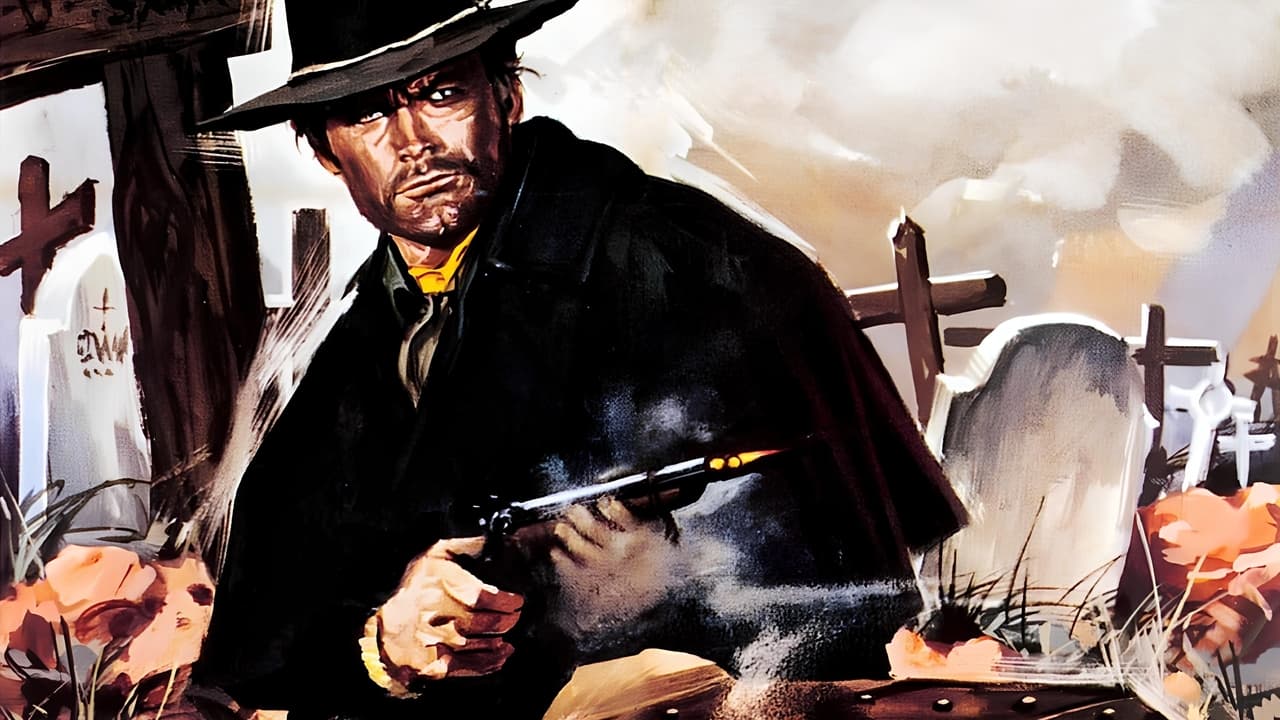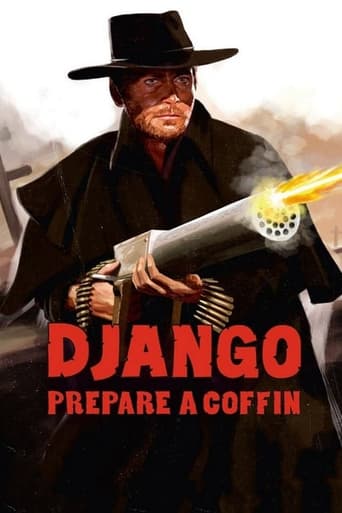zardoz-13
If you're counting, "Django, Prepare A Coffin" (1968), starring Terence Hill, was writer & director Ferdinando Baldi's second Spaghetti western. "Texas, Adios" (1966), with Franco Nero, marked Baldi's debut in the genre after years of helming sword and sandal sagas such as "Duel of Champions" with Alan Ladd and "Son of Cleopatra" (1964) with Mark Damon. Baldi would later make other westerns, such as "Rita of the West" (1968) with Terence Hill, "Forgotten Pistolero" (1969) with Leonard Mann, "Blindman" (1971) with Tony Anthony, "Get Mean" (1975) with Tony Anthony," and finally "Comin' At Ya" (1981), with Anthony again. Meantime, Corbucci's landmark western "Django" (1966) inspired countless in-name-only knock-offs galore. Eventually, Nero starred in director Nello Rossati's lackluster sequel "Django Strikes Again" (1987) that bore little resemblance to Corbucci's muddy western revenge opera. Django still has his faithful machine gun in this adventure yarn set in South America with our hero trying to become a monk. Nothing about "Django Strikes Again" has anything to do with the dusty Old West. The film seemed like another one of those Italian jungle movies about mercenaries. One of the many "Django" westerns that followed in the dust of the original "Django" was Baldi's "Django, Prepare A Coffin." Reportedly, Franco Nero was offered the lead role, but the actor headed off to Hollywood instead to co-star with Richard Harris in the Warner Brothers' musical "Camelot." Searching for a suitable actor to replace the steely-eyed Nero, Baldi settled on blue-eyed Terence Hill, who had previously been in two German westerns based on Karl May's western novels about the Native American character "Winnetou." At this point in his career, Terence Hill had yet to poke fun at westerns with his "Trinity" movies. Indeed, Hill plays it straight without a hint of humor in this shoot'em up. Moreover, Hill's Django differs from Nero's Django. While the streets are still muddy, Django appears here as if "Django, Prepare A Coffin" were a prequel. Django's hands haven't been stomped and broken so badly that he cannot shoot a six-gun. If you recall the original "Django," the eponymous hero desperately sought to balance a six-gun on a graveyard cross in a cemetery so he could kill the villainous Eduardo Fajardo. In "Django, Prepare A Coffin," Django's hands are as good as new, and he is a crack shot with a revolver. Like Nero's Django, Terence Hill's Django is married, but he has been working for a greedy, unscrupulous politician, David Barry (Horst Frank of "The Grand Duel"), but he stops working for him so he can escort a wagon-load of money to Atlanta, Georgia. Barry dispatches a cold-blooded killer, Lucas (George Eastman of "The Unholy Four"), to ambush Django and steal the gold. Lucas also kills Django's wife (Adriana Giuffrè) during the robbery. Five years elapse, and Django is nowhere to be found, but he has a job as a hangman. He wears black and he is unshaven. The catch is that Django refuses to hang anybody. Most of those criminals have been framed for their crimes by his own nemesis Barry. Instead, Django has fashioned a vest that enables him to fool spectators into believing that the condemned have been hanged. Essentially, Django drapes a hood over their heads so nobody can see that they haven't died. This sounds like what Blonde and Tuco did in Sergio Leone's "The Good, the Bad, and the Ugly." However, Django not only allows the condemned to live, but also requires them to join his gang that he is assembling to wreck vengeance on Barry. When three ungrateful men refuse to ride along with our hero and help him against Barry, Django guns them down in a fair fight. Somewhere along the way, one of the hanged men, a poverty-stricken Indian named Garcia (José Torres), decides to rob another gold laden wagon. After Garcia and his followers get the loot, each of them begins to die. The villains turn against themselves, and Garcia convinces them that they must cross over the border to be safe. While they are crossing the river, the treacherous Garcia picks them off like sitting ducks with his Winchester repeating rifle. By this time, the villains have learned about Django's plans for Barry. Barry's men capture Django and beat him up. The treatment that he suffers at their hands isn't as awful as what Nero endured in the original. Barry wants the money, and Django leads him to a sprawling graveyard where he plans to open a grave with the money in it. Instead, the coffin contains a machine gun, but Django uses it to wipe out Barry and his army of gunslingers. This is one of the standard tropes in Spaghetti westerns where one man wields a Gatling gun or a machine gun against the villains to mow them down.Although it isn't as great as the original "Django," "Django, Prepare A Coffin" qualifies as an above-average, dramatic, straight-faced Terence Hill western with little comedy, but plenty of action.
theactualtomsharp
This spaghetti western written by Franco Rosetti who worked on Sergio Corbucci's original Django, is what you can expect from one of the many Django movies from that era. This classic is a favorite of Tarrantino who contributed to The Django movies himself with Unchained. I found this film wildly entertaining, yet absurdly cheesy. The ending scene for example, the crowds of people ready to kill him and he just pulls the gun out of his coffin and shoots them all in the space of around 9 seconds. I think, personally, this is a film which reminds me why I love spaghetti westerns but also what most of the spaghetti westerns actually were, not all cinematic masterpieces like the works of Sergio Leone, but cheaply made, quite surreal and unrealistic, yet absolutely fantastic and entertaining to watch. Yet, this isn't a perfect movie, far from it.
TankGuy
This is the second in a new series of spaghetti western reviews, my first review was Django, an now i'm going to review it's sequel.Viva Django is an excellent film,although it may not be as good as it's 1966 counterpart, i still enjoyed it and it has a lot of action to keep the average action fan happy.The action includes shootouts and brawls that you would see in any spaghetti western. But one thing that really got me, was that Django dosen't use his iconic machine gun til the end of the movie where he guns down forty plus guys with it. This scene is still one of the best parts of the movie, but i would have liked it more if Djangos machine guns was used throughout the entire movie.The main theme,you'd better cry is excellent, Terence Hill is very good,but he's not as good as Franco Nero, i think he should just stick to spaghetti western comedies. I highly recommend this movie, it's available on Youtube,watch it.
RJC-99
Slow, boring and visually dead, this stinker doesn't come close to the original. The reason isn't mysterious: the director Ferdinando Baldi was no Sergio Corbucci.An assistant of the great Leone, Corbucci was a poet of ugliness. His mud-soaked towns, leering hookers, sadistic racists, and unforgettable image of Franco Nero dragging his coffin through it all made Django (1966) a high point in the genre. This was the western without Hollywood's vigorous airbrushing: Django an anti-hero shooting holes in the Klan and unsavory allies alike, his penitential coffin hauled through the muck of a corrupt post-Civil War society.Baldi is just a hack trying his best. Operating with no budget and rather less of a script, he turns in something like a bad, overlong TV episode. You get the watchable Terrence Hill, but few will want to suffer the bland cinematography and craptacular pace.

